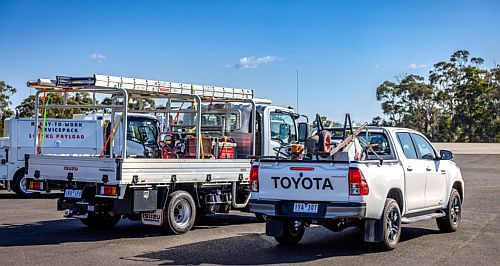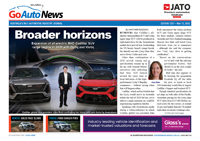Make / Model Search
News - IsuzuTradies tempted from utes to trucksIsuzu Trucks aims to tempt trade buyers away from utes and into light-duty trucks19 Aug 2024 ISUZU Trucks is on a mission to tempt trade buyers to light-duty trucks, promoting its car-licence suitable 4500kg GVM range as a higher productivity alternative to traditional utes.
However, as Isuzu Australia Limited (IAL) head of sales Craig White told GoAuto at a recent vehicle testing event at Lang Lang proving ground in Victoria, trucks are not the right choice for every would-be ute buyer.
“We know that we’re not everything to everyone, so we really want to drill down and focus on why it is that we should be targeting that crossover section of customers,” he said, while referring to a Venn diagram that included both truck and ute buyers, with a small portion that could ‘buy either way’.
“But there are those business-conscious customers that want the right tool for the job – they’re the guys we’re after.”
The truck-maker has sat atop the light-duty sales ladder for 35 years but is not one to get complacent, hence it is now aiming to attract fringe buyers that could probably get away with a ute.
“The bigger you get, the more growth is expected and the more you need to do to stay at number one,” said Mr White.
“We want to look after the customers we’ve got, but we also want to grow our breadth of customers.”
The IAL team believes trade buyers are an underutilised segment of the market, the vehicle equivalent of swing voters. These buyers run their utes near the maximum payload and tow regularly.
As the IAL team demonstrated at the iconic ex-Holden test facility south of Melbourne, a light-duty truck – even with a car-licence GVM of 4500kg – eclipses a ute in terms of outright productivity.
It is not just the significantly larger tray and body options that provide benefits. The 4500kg GVM N Series options have a GCM of 9000kg, which means that even when towing 4.5 tonnes, a full payload of up to 1700kg can still be utilised.
Most 4x4 utes and wagons, however, have a GCM of around 6000kg, so when towing the maximum 3500kg capacity – which most dual-cab utes are rated to – payload is heavily diminished.
In most cases, after subtracting the tare weight of a ute and trailer from the total GCM, accounting for passengers and any accessories fitted, owners are left with less than half the rated payload.
An equivalent light truck, however, can carry roughly a tonne more while also towing an additional 1000kg.
“That (payload) number gets diminished quite quickly when you start towing with a ute,” said IAL product manager of light duty trucks Jeff Gibson.
“So if you’ve got even a 2.5-tonne trailer on, you’ve got to take 250kg off your payload, and that goes up and up and up.”
This is only going to limit ute owners that regularly tow heavy setups while also carrying cargo or fixed toolbox setups in the tray, which IAL admits is likely only a small portion of the 250,000 ute buyers in 2023 – representing a staggering 20 per cent of total vehicle sales.
“Most of these customers don’t need a truck as a core part of their business, but it’s just the most efficient way to support what they do,” Mr Gibson said.
“They have a job to do and they need the right tool to do that job, but it also offers a safer work environment for operators.”
The pitfall of American-style pick-up trucks as an alternative to traditional utes, IAL points out, which can tow 4.0- to 4.5-tonnes while remaining driveable on a car licence, is their sub-1000kg payload capability.
Isuzu Trucks rolled out its Tradepack range in 2003, which has evolved to become part of the broader Ready-to-Work range that includes everything from simple alloy tray back options to versatile tri-tippers.
The benefit, IAL says, is factory support and models that are ready for a jobsite, mine site or day-to-day trade work straight out of the box, without needing to visit a bodybuilder.
“It’s all about turnkey solutions and that’s overwhelmingly what customers want. They want to rock in and rock out with something rather than wait 18 months,” Mr White said.
IAL has 37 dealers around Australia, but Mr White explained that many of the dealer groups own additional sites that will support Isuzu Trucks customers.
This is key, given competitor ute brands typically have hundreds of dealerships around the country.
“Our success is really built on the back of our dealer network, and when we’re targeting these ute-based customers it’s important to have that network and the principles behind looking after customers,” Mr White said.
“That’s key to this growth strategy as well as ensuring customers' needs are met through our dealer network.”
Mr Gibson echoed the importance of a strong dealer network, but explained that the truck dealership experience was quite different from that found in consumer car showrooms.
“It’s how we look after the customer after we’ve sold it, so it’s really that business partner approach,” he said.
“At commercial dealerships, it’s all about uptime – getting that truck back on the road as soon as possible. It’s very focused on the business operation rather than that emotional experience.”
In bridging the gap, Mr Gibson said that Isuzu Trucks offers a warranty on par with those offered in the passenger car market, which includes an optional Essentials Plus prepaid servicing arrangement.
“So we have a six-year warranty for the truck itself, then the body comes with a three-year warranty – but if you were to bespoke build something, most bodybuilders would generally give you 12 months,” he said.
“Equipment service agreements are a growing thing now, so people have that fixed cost with Essentials Plus. We don’t have capped-price servicing like many people are used to, but we offer a fixed cost that is basically broken up into monthly payments.”
Trucks have become more ‘car-like’ to operate in recent years, with light-duty models benefitting from independent front suspension (IFS) and torque converter automatics.
Inside, infotainment systems rival those found in dual-cab utes and the active safety system in the N Series trucks is the same as the one used in Isuzu D-Max models.
The IAL team believes light trucks will become even more car-like as technology progresses, hinting at the user-friendliness of its new range which is expected to launch next year.
“There is so much change happening in our industry, and this will make the car-like experience even more important,” said Mr White.
“With the new vehicles that are coming in, there will be new engines, new transmissions that will make this proposition even easier.”  Read more |
Click to shareIsuzu articlesMotor industry news |












Facebook Twitter Instagram